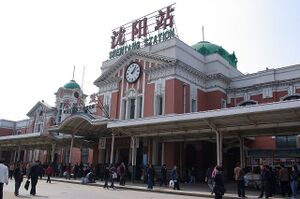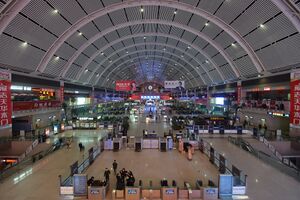Shenyang
| Shenyang | |||||
|---|---|---|---|---|---|
| Japanese Name | シェンヤン | ||||
| Weapon | |||||
| Race | Human | ||||
| Nationality | |||||
| Birthday | October 1 | ||||
| Constellation | Libra | ||||
| Talents | Cooking, Fights | ||||
| Likes | Dalian | ||||
| Dislikes | Those who leave work to others and do not attempt to do something about it themselves | ||||
| Strengths | Has nerves of steel | ||||
| Weaknesses | Short-tempered | ||||
| Hobbies | Cooking | ||||
Tianlaohui's Shenyang, that's my name. I have volunteered to join the SSS too because my boss joined. I'm always ready for a fight. Please leave any dirty work to me.
Layers
| Icon | Title | Release Date | Where to Obtain |
|---|---|---|---|
| [Tianlaohui Savage Dog] Shenyang | 2024 January 22 | [Altar of Judgement - Snow Ghost Tsurara Chan] Event Reward | |
| [For Dalian] Shenyang | 2024 January 12 | [The Uncaught Racoon in Jiulong Castle] Pick Up Gacha, Premium Gacha | |
| [Reach Out to Friends] Shenyang | 2024 January 22 | [The Good Friend and the Loyal Sister-in-law] Limited Gacha |
Owned Skills
Trivia
- Shenyang's birthday is the completion of the Shenyang station railway building in 1910.
- Similar to Dalian, Shenyang's theme is based on China's triad mafia. Shenyang is notorious as a base of operations for both Chinese triads and the Russian mafia, the former said to actually be sponsored by the Chinese government in secret. Both Dalian and Shenyang are located in Liaoning province.
- Shenyang city is also the headquarters of the Shenyang Aircraft Corporation, responsible for much of China's military aircraft production and design. Many of Shenyang Aerospace's designs are derived from Russian originals, in line with the hybrid German/Russian/Chinese nature of Eisengrad as a whole.
- Shenyang's weapon of choice is a repeating crossbow. Although the repeating crossbow was in use throughout most of Chinese history until the late Qing dynasty, it was generally regarded as a non-military weapon suited for women, defending households against robbers, and even hunting.
- The building in the background of [Reach Out to Friends] is the facade of Shenyang Station. The Chinese word "沈阳站" and English word "Shenyang Station" is fairly discernible, the real life version lights up at night.
Counterpart
Shenyang Station (simplified Chinese: 沈阳站; traditional Chinese: 瀋陽站; pinyin: Shěnyáng Zhàn) , formerly known as Mukden Station and Fengtian Station, is located in Heping District, Shenyang, Liaoning, China, and is a special class station under the jurisdiction of China Railway Shenyang Bureau Group. The East Station Building of Shenyang Station was opened on October 1, 1910, and was designed by Tsuyoshi Ota and Sotaro Yoshida, students of Japanese architect Jingo Tatsuno. The west station building of Shenyang station has been put into use on July 30, 2012, synchronized with the Harbin-Dalian high-speed railroad.
In 1891, Tsarist Russia invaded Northeast China and began construction of the Siberian Railroad. In order to seize the northeastern region of China, the tsarist Russian government put forward the request to extend the Siberian Railway to the territory of northeastern China. In 1896, the tsarist Russian government and Li Hongzhang signed the Sino-Russian Secret Treaty, the Qing government allowed Russia to build from Chita through the northeast to connect with the tsarist Russia Ussuri Railway of the East Qing Railway, and in 1899, built to Shenyang. Fengtian station (simplified Chinese: 奉天站; traditional Chinese: 奉天站; pinyin: Fèngtiān Yì) is then opened in 1899, which was a very simple shack at the time. In 1904, Fengtian station was occupied by Japan after the start of the Russo-Japanese War and renamed Mukden station. In 1907, the annual number of passengers reached 500,000 for a population of 300,000 in Shenyang. As the number of passengers increased, it became impossible to handle the number of arriving and departing trains, and the Railway decided to build a new station at the intersection of the Anfeng Line and the South Manchuria Railway Main Line.
After the new station was completed, Mukden Station became the largest of the five major Manchurian Railway stations at the time. On October 1, 1910, a ceremony was held to move the station, and Mukden Station was moved to its current location, now Shenyang Station. A new city was formed afterwards around the station, and roads were formed radially to the east centering on the Mukden Station. During the Manchukuo period, the station played an important role as a relay station for transporting goods from various parts of northeastern China to Dalian and then to Japan by ship. During World War II, five cargo warehouses at Mukden Station were destroyed by the U.S. Army from December 1944 to January 1945. After 1945, Mukden Station was renamed Shenyang South Station. After the liberation of Shenyang, the Sino-Soviet railroad was established, and Li Liankui was the first stationmaster.
Shenyang South Station was later officially renamed Shenyang Station in May 1, 1950. Shenyang Station's passenger ticket office was completed and put into use in May 30, 1982. After the opening of the new Shenyang North Passenger Station, Shenyang Station was converted to a freight station to handle the management of short-distance and ordinary trains and as a freight yard. In 2007, the Harbin-Dalian Passenger Dedicated Line planned to renovate Shenyang Station. The renovation project officially started in 2010, with plans to build a new west station house in Tiexi District and to rebuild the elevated waiting room. On July 30, 2012, the west station building of Shenyang Station was officially put into use. 2014, the relocation project of the freight yard was completed. Wikipedia
Shenyang (simplified Chinese: 沈阳; traditional Chinese: 瀋陽; pinyin: Shěnyáng), formerly known as Fengtian or by its Manchu name Mukden, is a major Chinese sub-provincial city and the provincial capital of Liaoning province, in north-central Liaoning. It is the province's most populous city, with a population of 9,070,093 at the 2020 census. It is also the largest city in Northeast China by urban population. Shenyang is the central city of one of the major megalopolises in China, the Greater Shenyang Metropolitan Area, with a population over 23 million. The city's administrative region includes the ten metropolitan districts of Shenyang, the county-level city of Xinmin, and two counties: Kangping and Faku.
Shenyang has passed through the control of many states and peoples in history. In the 14th century, Shenyang came under the control of the Ming dynasty. The city served as an important Chinese military stronghold during the Ming period. The Manchu people conquered Shenyang from the Ming in the 17th century and briefly used it as the capital of Qing dynasty China. In 1905, the Battle of Mukden took place south of Shenyang during the Russo-Japanese War. Japan's subsequent victory allowed Tokyo to annex the region west of the old city and to increase Japanese influence on Shenyang; in 1931, the Mukden Incident led the Japanese to further invade and occupy the rest of Northeast China, forming the puppet state of Manchukuo. After the Japanese surrender in 1945, Shenyang remained a Kuomintang stronghold, but the Communists captured it in 1948 after the Liaoshen Campaign.
Along with its nearby cities, Shenyang is an important industrial center in China, and serves as the transportation and commercial hub of China's northeast—particularly involved in links with Japan, Russia and Korea. A center of heavy industry in China since the 1930s, and the spearhead of the Chinese central government's Northeast Area Revitalization Plan, the city has been diversifying its industry, including expanding into the service sector. Growing industries include software, automotive and electronics. Wikipedia
Map
Gallery
- Pages using Tabber parser tag
- Pages using DynamicPageList3 parser tag
- Weapon Bow
- Human
- Eisengrad
- Libra
- Element Pierce
- Element Fire
- Element Dark
- Train Knights
- China













